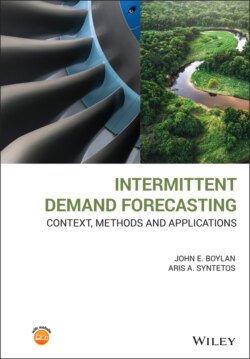Читать книгу Intermittent Demand Forecasting - John E. Boylan - Страница 51
2.5.3 Periodic Review Policies
ОглавлениеThe inventory control systems have been claimed, on the basis of theoretical arguments, to be the best for the management of intermittent demand items (Sani 1995). Many policies have been developed in the academic literature, some giving optimal solutions (e.g. Veinott and Wagner 1965), and some not (e.g. Wagner 1975; Naddor 1975; Ehrhardt 1979; Ehrhardt and Mosier 1984; Porteus 1985). The policies that are non‐optimal are ‘heuristic’. ‘Heuristics’ here refer to the use of some (more) easily implementable rules and calculations, which reach a solution that may be close to optimal but does not necessarily achieve optimality (Sani and Kingsman 1997; Babai et al. 2010). Optimality is sacrificed in favour of some increased practical applicability.
In practice, systems are not used as much as systems. This emphasis is reflected in the academic literature, where the latter has been researched more extensively. We now turn our attention to the (or ‘order‐up‐to’) inventory policy and the reasons for its popularity.
Hadley and Whitin (1963) noted the differences, in the computational effort required, to generate results for the system and or type policies. They identified the circumstances under which the order‐up‐to policy is essentially optimal, meaning that the average annual costs differ so little from other policies that it is not worth making the additional computations. The answer depends on the relative magnitudes of the ordering and review costs. As previously discussed, the former comprises such things as raising invoices and the cost of the personnel working in relevant organisational departments. The latter reflects such things as inventory software investment and managerial time spent on reviewing SKUs' inventory positions.
When the ordering costs are low relative to review costs, an order‐up‐to policy should be almost optimal. All three policies (, , and ) incur the same review costs (for the same review interval, ), but the policy leads to more frequent ordering, everything else being equal. If the additional ordering cost is low, its impact on the relative cost performance of the policy is only minimal, and worth incurring in light of the ease of implementation of such policies.
Sani (1995) developed a stock control model that reflected the main characteristics of a real inventory system. The model was of the form where an overnight emergency delivery was offered in the case of a stockout. The model was used to conduct a sensitivity analysis of the inventory costs and customer service levels achieved by employing the real system. Sani argued that the system represents many real‐world cases and is intuitively and computationally more appealing to practitioners than the system. Moreover, using to coordinate ordering over multiple SKUs is preferable to using (which would vary across SKUs). It is also easier to optimise the system, as we know that the inventory position will be back up to at every review point. Finally, policies have been shown to be very robust (Bijvank et al. 2014) and that may help further explain their prevalence in real‐world applications. Most of the empirical studies in the area of intermittent demand forecasting and stock control have considered an system.
All three periodic review systems discussed in this chapter are possible candidates for implementation with intermittent demand items. Arguably, there are some disadvantages associated with the and policies, but the evidence is not conclusive. systems seem to be appropriate for intermittent demand. Although they may not be universally recommended for application, they are very appealing both in practical and theoretical terms. If the review interval has been determined, then there is only one parameter to optimise (). This simplifies calculations and enables a more focused discussion about optimisation and the integration of forecasting into inventory calculations, than dealing with two parameters (which would be the case for and policies).
The periodic order‐up‐to level system will be used for the remainder of this book. However, before we close this section some variations of this system should be discussed. This follows in Section 2.5.4.
